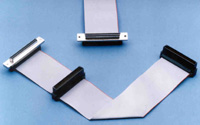 Photo ©1998 AMP INC.
Photo ©1998 AMP INC.One of the most important concerns in the design of contacts is the initial contact force. Considerable effort is required to provide the right beam geometry and the right deflection, and to select an alloy with the necessary strength and adequate formability. But these initial efforts must not be the only concern because some metals lose a significant amount of their initial contact force over time. This decay of contact force, a natural consequence of the structure of all metals, is called stress relaxation. Stress relaxation is the time dependent decrease of the stress in a metal under constant strain, such as in a beam with fixed deflection. (The metallurgical processes are similar to those that cause the related phenomenon called creep, where the metal changes geometry over time under a constant stress.)
All of the copper alloys are susceptible to stress relaxation, just as are all other metals. But there is a tremendous difference in the stress relaxation between different copper alloys, so alloy selection can be important. In the strictest sense, stress relaxation always occurs, over time, in any stressed member of a connector. But in a practical sense, some applications will experience very small losses of contact force. For highly resistant alloys, under moderate stress for short times, without exposure to high temperatures, the decrease in contact force will be within the experimental error of pre-production testing.
Stress relaxation is a function not only of alloy, but also of temperature, temper, orientation, initial stress, and, of course, time. To prevent circuit integrity from being compromised over the design life of connectors the loss of contact force due to stress relaxation must be taken into account. When should the designer be concerned? During alloy selection because, as previously noted, there are significant differences among the alloys used for connectors.
